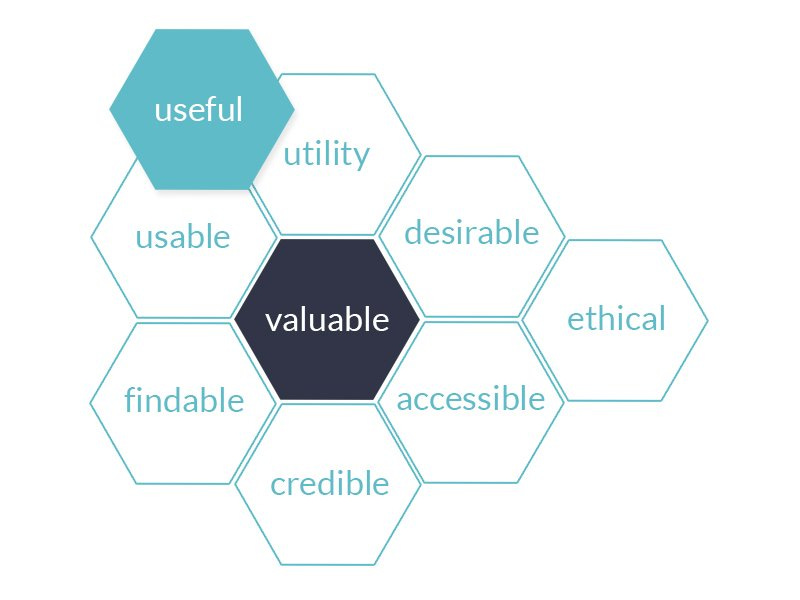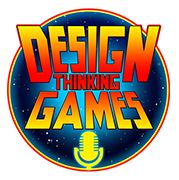Games discussed on this episode:
- The UX Honeycomb
- Dead by Daylight
- Hellblade: Senua’s Sacrifice
- Fall Guys
- That Dragon Cancer
- Edith Finch
- Heavy Rain
Introductory Guy
Welcome to design thinking games, a fantasy and user experience podcast. Each episode, your podcast host, Tim Broadwater and Michael Schofield will examine the player experience of board games, pen and paper role playing games, live action games, mobile games, and video games. You can find every episode including this one on your pod catcher of choice. And on the web at design thinking games.com.
The UX Honeycomb
Michael Schofield
[We’re talking about a model] called the UX honeycomb, which I believe was first introduced by Peter Morville.
Tim Broadwater
I believe he’s actually like you. He has a degree in library science. He started semantic studios. And I think his background is essentially in information architecture discoverability findability, and then my understanding of it.
Michael Schofield
It supposed to look like the inside of a honeycomb. When it comes to UX, all ships rise and lower with the tide. One of its primary goals was to decouple this idea that UX equals look and feel and aesthetics that I think a lot of folks have, and that in fact a lot of job descriptions in the wild have right now where they’re looking for UX people, but what they’re really looking for are graphic designers.

This honeycomb kind of helps show that the user experience is made up of a whole bunch of things that aren’t look and feel. And in fact, you can invest heavily in these non aesthetic qualities, like the credibility of a thing, or the findability of a thing, and not invest so much in the user interface itself, and still come away with a net positive experience.
Tim Broadwater
Yeah, I agree with you. And I think I’ve used it because I think it helps with priorities. Are we being accessible? Is this credible? Do they even desire to use this? And do they know how to use it?
From that, we were talking about your UX honeycomb. Can you give us a little history of that? Because you I think you took it and then kind of on a little bit years ago, right?
Schofield’s Honeycomb

Michael Schofield
So for our audio listeners who aren’t looking to anything, there are traditionally six facets. In no particular order, because I’m doing this for memory. They are:
- desirability, which I think describes sort of the look, feel, the aesthetics, the funness. Maybe the gimmickiness?
- Then there’s accessibility, that’s a really hard one to kind of like boil down.
Tim Broadwater
Well, mainly, I take that more as like, inclusivity. As people need peripheral devices or, you know, if they have visual different visual acuity or disabilities, you know, that piece of that honeycomb?
Michael Schofield
It’s the answer to the question, can you access or utilize this service across multiple devices, but that’s accessibility, they’ll find stability.
- There’s discoverability. The ease of which that information within the service or even information about the service itself can be discovered. Through search, filter information, architecture.
- Credibility, how much trust a user has in the service and is more more specifically the people behind the service?
- Usable: can you use it? Does the button depress? It’s the spectrum of ease of use, whether it is easy or not. But that usability is a factor.
- and whether it’s Useful.
So with that in mind, I made a honeycomb , frankly, because after a couple of webinars trying to explain the the honeycomb to our colleagues in higher education. There were just some questions and confusion around aspects like usefulness that I just wanted to clear up. But also they’re asking questions more like, gosh, like what role does privacy, user privacy or ethics, eco friendliness, etc, have in the honeycomb.
So in this LibUX honeycomb — for “library user experience” honeycomb — that I made, I did a couple of things. One, I conflated or I guess I abstracted, useful into, and usable into a little bit of a triumvirate that there’s this was based off Nielsen Norman group’s definition of usability. And so there’s usability, which is specifically like its learnability, its ease of use, there’s a utility, for instance, something can be very easy to use. But if it has no practical utility, like in the real world, that has some impact. And usefulness is sort of a cumulative of those two, I think, is useful if it is both if it both has utility, and is usable.
The only other thing I did was add ethical to it, because Peter Morville makes the point himself that yo, it’s a honeycomb, because you can mix mingle, and add as many different facets of the user experience as you want.
Using the honeycomb as a lens to talk about games
Tim Broadwater
Using your honeycomb. We challenged each other to find a game, tabletop, video game, live action board, game, whatever, that we beat that each other or like we ourselves thought, best represented, like an embodiment of this value of this. Are you ready to reveal what you chose and what it is?
Michael Schofield
Yeah, I’m curious which one you would start with?
Dead by Daylight
Tim Broadwater
So for me, I chose and this is because it’s, it’s also on my mind right now. And I’m playing the crap out of it. Dead by Daylight. It’s an asymmetrical survival horror game. Essentially, it’s on every platform. It’s been out since 2016. So it’s like seven years in development.
Michael Schofield
Wow. I remember when it came out, I can’t believe it’s been seven years now.
Tim Broadwater
It is amazing. I love it. And we’ve talked before and you know that I’m a huge fan of asymmetrical survival horror, and I’m a huge fan of MOBAs, which are like these massive online battle arenas. And so games like Monster Hunter, Friday the 13th, Predator Hunting Grounds, like those games really speak to me because you basically customize your character, how you want them to look, and, and then you give them perks or experience or whatever. And then essentially, you go into a timed battle. And depending on what it is, you know, you’re surviving or trying to meet an objective or you’re trying to survive.
But the asymmetrical survival piece of it is that with Dead by Daylight, five players go in, one of them is a killer, and the other four are trying to survive. And so by surviving, you have to repair you’re kind of trapped in this arena, and you have to repair these specific engines, five of them to open unlock the gate so you can survive and the whole time you’re hiding from this killer monster, and who is going to pretty much like capture you enter you hanging on a hook kill you like anything as brutal as possible.
And I think that really to me represents this great usability, great development, and meets a lot of these honeycomb pieces. What about you?
Hellblade: Senua’s Sacrifice
Michael Schofield
What I ended up with were a number of examples that I think fail and certain parts of the honeycomb and are great, and the others, but I think, overall, is I think one of my favorite games of the decade: Hellblade: Senua’s Sacrifice.
One, just in terms of its usability and learnability and the way that they teach you to play through listening to aural cues. One of the big things that Senua’s Sacrifice did was give you this kind of 360 degree audio experience. The other extreme of this honeycomb, like just it’s just its inclusivity. Basically creating a character who is neurodivergent, right, like whether or not like she hears she hears voices, whether or not these are the spirits of her ancestors or not, is left up to the user, but these voices teach you how to play the game.
Tim Broadwater
What’s the game about for those for those who have not played it before?
Michael Schofield
Senua is a sixth century Celt, maybe. I think her people are resisting either Anglo Saxon or Norse invasion. You play as Senua. She’s treated like a witch, right? She’s a “seer.” She has visions. See, she speaks to those who are imperceptible and la dee da, da, da. Your entire community has been totally oppressed and Senua seeks vengeance, someone has been taken from her and she goes after them. It is descent into questionably madness, or a spiritual realm where the spirits and the deities of the Old Norse have actually interwoven themselves in the world and you fight these, these creatures, these gods and their spawn — or perhaps that’s purely how you perceive them. And what you’ve been engaged in all this time is the slaughter of an enemy tribe.
Tim Broadwater
Oh, my gosh, it’s a little crazy. Yeah. I’ve never played it. And I’ve heard really good things about it, you know, and I know it got a lot of rave reviews, like a lot of people. It’s ranked, I believe it’s, it’s rated pretty high.
Accessibility in Dead by Daylight, Fall Guys
I want to speak a little bit more to Dead by Daylight concerning accessibility. And this is gonna be a tangent a little bit. But we’re now in you know, 10 years, suddenly, or 20 years solidly into the 21st century.
If you’re making a game, and you’re not letting people turn on and turn off rumble on the remote, or you’re not letting people invert their y axis, or add subtitles, you’re doing something wrong.
One of the games that I noticed here in the last year that came out, which was really crazy popular was Fall Guys. Essentially, you make up a character, and you go into this thing, and you’re trying to race and run through the end all these weird obstacles. You cannot invert your y axis and it pissed me off.
There are a huge amount of players who literally come from a pilot kind of mechanics and HUD background, a lot of MMORPGs are built that way to where, you know, when I push forward on the remote, which is up on the control pad, I want to look down. And it’s not just like shooting gallery and console, so you kind of have to give both options.
Which is probably the reason why I didn’t play it that long. It’s messing me up, you kind of have to provide that.
Dead by Daylight got into a little bit of trouble a while ago because one of their developers was streaming on Twitch. And they basically were talking about like, “we know accessibility is a problem. The community keeps saying it. The developers don’t even care that there’s people that have different color blind accessibility issues.” So it blew up over the web, right?
Because of this then they fast tracked it based on the response that they got. They are actually putting it into the next patch of the game. So you can actually see items that are highlighted with different visual colorblind kind of measures. And so I really liked that fact that they’re listening to their community through the forums.
If the users are telling you, “Hey, this is something we want to see,” maybe you should prioritize it.
I don’t know many games that allow you to do that. I know that there’s a couple of different way you can control contrast and brightness and, and different color modes and games like Ghosts of Tsushima.
I think we’re seeing more games that are now taking that into consideration to where you just can’t give people lightness or brightness meter, you’re gonna have to kind of give them different things. And if you’re not giving them you know, rumble capabilities, captions, you know, rumble cues to replace audio cue different things for different visual acuity or colorblindness, you know.
Utility, not Desirability, in “That Dragon, Cancer”
Michael Schofield
I struggled with finding a game I want to nominate in terms terms of its utility, because I was looking for an example which downplayed the role desirability or even “fun” has on a cumulative experience. I’m curious if you played it or heard of it, called “That Dragon, Cancer?”
Tim Broadwater
No, not heard of it.
Michael Schofield
This is a game that was created by a really small team. And it is effectively an autobiographical experience where the developers … their son was diagnosed with terminal cancer at I think about a year old. And it gave him only a really short time to live, he survived for four years and then died. So they put together this game to tell the emotional side of that story, you have different puzzles, and you navigate from one room to the next. And playgrounds that morph into hospital rooms. And there’s always, you know, this kind of like child’s laughter, somewhere like over the horizon. And it’s extremely sad. Like when I finished the game, I cried.
I’m getting, I’m getting choked up, like thinking about it.
But I’m trying to think of a game in terms of its utility. Is it fun? No, like, absolutely not. This is not a fun game.
To me, its chief value is that it either provides an artful outlet for folks who have experienced, like cancer based death in the family or illness based death and provide some kind of like outlet, or it provides this kind of educational mapping, it creates neurons that weren’t there before. To effectively develop a person’s empathy as a piece of training. It’s a piece of emotional training.
And if I am yet to the point to think about this in terms like Morville’s or our honeycomb here, no one would disagree that this is a net positive user experience and as well an incredibly sad experience, which I think is really interesting to conflate that like a good UX has nothing to do with delight. Right? That delight is ancillary. It is a byproduct, but it is not required for good UX.
Tim Broadwater
It reminds me of – have you ever played the other indie game? What Remains of Edith Finch?
Michael Schofield
Yeah I’ve started, I’ve never finished it.
What Remains of Edith Finch
Tim Broadwater
It’s very similar to where like, you’re literally walking down your family history. There’s a curse. Everyone dies mysteriously or goes missing, or something bad happens to them and so you’re kind of the youngest member of this family, piecing together your past because it was unknown to you. And you’re just kind of unfolding all of these kind of tragic stories of your life, right, that you have your relatives that you didn’t know.
And I would say it’s definitely not like, when we talk about desirable meaning, or equating to fun that doesn’t always have to be fun, desirable, can also be as it relates mechanically, or what’s it doing for you as the player. It can be something like a narrative experience it can make you feel and think.
Heavy Rain
So I think that’s a good thought. You don’t get that in blockbuster games. That’s why there is such a huge market for indie games. And even in this I don’t know if it’s a double A or triple A game. I don’t think it is. But Heavy Rain. Have you heard of that game?
Michael Schofield
Oh, I have. And as a non PlayStation owner, I am so sad that I’ve never played it.
Tim Broadwater
Essentially, it is a choice driven game. It’s very much like Detroit: Become Human. Or Beyond Two Souls or any game to where it’s just a story that you’re making choices through. But in that regards, Heavy Rain is where you’re controlling the character from different perspective, different characters from different perspectives a father, who’s a single father, you know, a detective and this woman and then essentially it’s painful, because you’re tracking down a serial killer who’s captured this single-father’s son, who this woman is reporting, investigating and this and this detective is hoping to find and but what happens and, and I’m not going to ruin it.
But essentially, what unfolds is you find out through the course of the game, why the serial killer is doing what he’s doing. And you can’t help but empathize.
[At the end of the game] you’re not the same person.
In summary
Michael Schofield
Playing games with a knowledge of these kind of, you know, design thinking constructs, is that you can appreciate them and their different facets, right, the honeycomb is effectively a kaleidoscope, right? Look at a game through any particular lens, any particular facet?
Tim Broadwater
It’s a different way of seeing. They speak to emotional needs, design needs, business needs, player interaction, but it’s a way to kind of start looking at how we look at games, experience them, transform what we’re seeing, or lets us look or explore a little bit beyond you know, what’s there. And there’s all types of games and there’s all types of players.
Introductory Guy
Thank you for listening to the design thinking games podcast. To connect with your hosts, Michael or Tim, please go to designthinkinggames.com where you can request topics, ask questions, or see what else is going on. Until next time, game on



